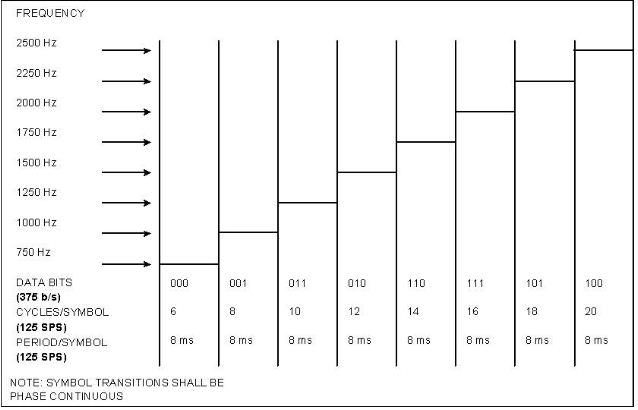

HF Digital Messaging - Emergency / Disaster Relief - Interoperative Communications - Ham Radio
















|
ALE Automatic Link
Establishment
(MIL-STD-188-141; FED-STD-1045)
Audio waveform showing the shift in frequency of the 8-ary FSK signal transmitted by ALE A.5.1 ALE modem waveform. 18 A.5.1.1 Introduction. The ALE waveform is designed to pass through the audio passband of standard SSB radio equipment. This waveform shall provide for a robust, low-speed, digital modem capability used for multiple purposes to include selective calling and data transmission. This section defines the waveform including the tones, their meanings, the timing and rates, and their accuracy. 19 20 A.5.1.2 Tones. The waveform shall be an 8-ary frequency shift-keying (FSK) modulation with eight orthogonal tones, one tone (or symbol) at a time. Each tone shall represent three bits of data as follows (least significant bit (LSB) to the right): · 750 Hz 000 · 1000 Hz 001 · 1250 Hz 011 · 1500 Hz 010 · 1750 Hz 110 · 2000 Hz 111 · 2250 Hz 101 · 2500 Hz 100 The transmitted bits shall be encoded and interleaved data bits constituting a word, as described in paragraphs A.5.2.2 and A.5.2.3. The transitions between tones shall be phase continuous and shall be at waveform maxima or minima (slope zero). 21 A.5.1.3
Timing.
22 A.5.1.4
Accuracy.
 figure A-5 - ALE Timing and Coding. |

















END OF PAGE
©2000, 2001, 2002, 2003, 2004, 2005, 2006, 2007 HFpack Inc. All Rights Reserved.
HFLINK, HF-LINK, HF LINK, and the HFLINK Logo are trademarks of HFpack Inc. Any external hyperlinks must only be to the main page of the HFLINK.COM website http://hflink.com . Capture of the HFLINK website or any part of it within the frame of another website is not permitted. HFLINK group forum is a private group. Public archiving, forwarding, or open display on the internet of HFLINK group forum or messages is forbidden. All text and images on the HFLINK website are property or copyright HFpack Inc, or when used by permission, are copyright by their respective owners, with all rights reserved.
HFN and High Frequency Network are service marks and trademarks of HFpack, Inc. No part of the HFLINK website or HFLINK Group Forum may be used or copied without written permission of HFpack Inc.



